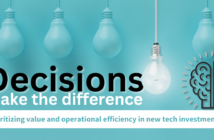Technology has an important role in the modern hospitality guest experience
by Jady West
In the age of the on-demand guest, hotels are facing an evolving expectation of what a “home away from home” really means. Hotel patrons of the past expected hot water and a comfortable mattress, but today’s travelers are looking for streaming services, high-speed Wi-Fi, and app-based check-in – all from the comfort of their room.
Approaching the tech-focused generation of customers isn’t an easy task, especially as legacy hotel brands must work to advance their offerings without losing the charm of existing properties or alienating the less tech-savvy. Even harder still is the fact that having all of these amenities changes the entire experience from check-in down to how a lobby or room looks and feels.
Aside from adding new devices to the in-room experience, technology, and the infrastructure to support it, is shifting how hotels approach design. Let’s explore ways your hotel can take the guest experience to the next level, and the best ways to evolve your design plans with it.
FRONT DESK FACELIFT
Innovation can be first experienced right as guests arrive at your hotel. For many modern properties, gone are the days of the large banks of concierge and check-in desks. Digital check-in is on the rise, as 68 percent of guests want to speed up the check-in process by using their smartphones, according to Zebra Hospitality’s 2016 Vision Study. But for many properties, they will now need to change the function of these spaces to adapt to a streamlined check-in culture.
However, the hotel lobby likely isn’t going to completely go away any time soon. But it will look a bit different and serve a separate purpose. In the place of concierge desks, some hotels have modern, self-serve kiosks that they can use for check-in or folio review. A prime example of this trend is the new CitizenM hotel in Boston. Now the lobby resembles a “hip coffee shop,” giving customers a relaxed spot to wait for their rideshare or meet up with a traveling companion that is more closely related to a cozy living room vignette than a traditional hotel lobby.
But even as technology continues to permeate nearly every aspect of the guest experience, there are some things the world just isn’t ready for. A recent Cox Business study found that 60 percent of guests found robot bellhops to be more “creepy” than “cool.”
But aesthetics aren’t the only focus for hotels. From a technology standpoint, hotels need to ensure they have high-density Wi-Fi strategically placed in high-traffic areas to support tech-driven conveniences like digital check-ins, checkouts, and account review, as well as a large volume of personal devices that will traffic these areas. Technology is changing design, and that will change the technology required to support it, as well.
DON’T FORGET DIGITAL SIGNAGE
With these new experiences like a kiosk-only check-in, guests are more likely to need guidance to navigate the property. Clear signage and wayfinding markers are a necessity to help usher guests through a possibly unfamiliar process.
Static signage is on its way out in favor of flexible digital signage that can be updated more frequently and streamline wayfinding. Going digital also gives hotels the opportunity to utilize wayfinding as a focal point of design or advertising, all while streamlining traffic flow.
IN-ROOM IS EN VOGUE
When guests arrive at their rooms, they expect more than just creature comforts. They want the type of experience they’re used to at home. In fact, according to a study by Pew Research, almost half of Americans use digital voice/AI assistants and one in six uses “smart” speakers at home, according to a study by NPR and Edison Research. This rise in at-home gadgets is also fueling the need for them to become more commonplace in hospitality.
But adding in-room streaming capabilities and Amazon Alexa isn’t always just as simple as “plug and play.” The room design will often need to shift to be centered around technology or customizable in-room experiences. Even the average TV-watching experience is changing, as many hotels use smart TVs to enhance the over-the-top (OTT) content experience through streaming services/devices or casting options. Technology that can even be leveraged for customizable ambiance, like art, is now a possibility through augmented reality. Just look at Marriott and Lifewtr’s recent in-room partnership.
Hotels should also prioritize in-room tablets that control in-room technologies and design elements. The same Cox Business survey found that one-third of surveyed consumers felt that an in-room tablet with functionality to control lights, temperature, entertainment, and room service would be the top technology to improve their stay.
BEFORE YOU CHECK OUT…
In short, for hotels looking to bring their services into the modern age, it’s important to consider the lasting effects technology will have on design and infrastructure needs. When implementing a new experience, like self-serve check-in, consider how current spaces will need to be altered to maximize the spaces (and the Wi-Fi and other amenities that will be needed to support them). Make sure your signage is upgraded to be flexible and visually interesting, allowing for easy streamlining of traffic with a contemporary twist. Finally, don’t be afraid to bring smart technology into guest rooms, but be sure you’ve thought through the role each gadget will play in the guest experience. And for now, stay clear of the robots.
 Jady West is director of strategic sales for Cox Business and Hospitality Network. In this capacity, Jady works closely with CB/HN Leadership and leads a team of sales professionals in the rapidly expanding Strategic Accounts market. Jady is responsible for driving continued sales development and growth, strategic planning, cross-functional alignment, budgeting, and planning for the Government, Gaming and Lodging verticals, Hospitality Network, and the third-party Agent Channel.
Jady West is director of strategic sales for Cox Business and Hospitality Network. In this capacity, Jady works closely with CB/HN Leadership and leads a team of sales professionals in the rapidly expanding Strategic Accounts market. Jady is responsible for driving continued sales development and growth, strategic planning, cross-functional alignment, budgeting, and planning for the Government, Gaming and Lodging verticals, Hospitality Network, and the third-party Agent Channel.




